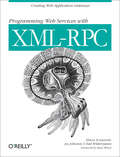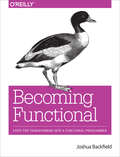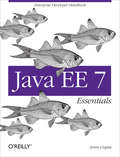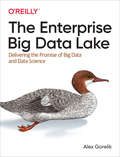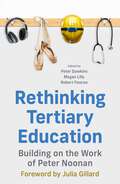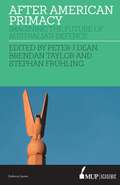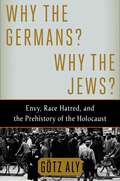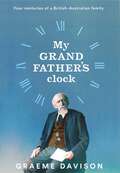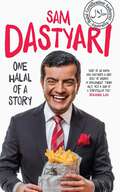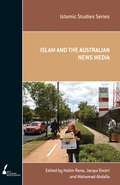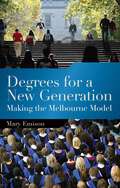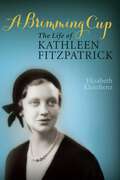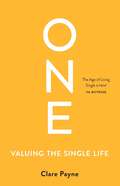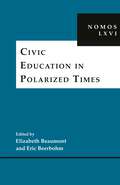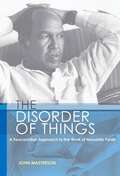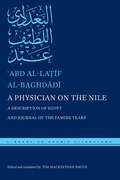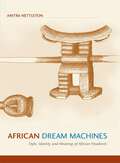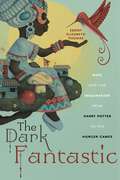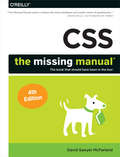- Table View
- List View
Programming Web Services with XML-RPC: Creating Web Application Gateways
by Joe Johnston Simon St. Laurent Dave Winer Edd Wilder-JamesHave you ever needed to share processing between two or more computers running programs written in different languages on different operating systems? Or have you ever wanted to publish information on the Web so that programs other than browsers could work with it? XML-RPC, a system for remote procedure calls built on XML and the ubiquitous HTTP protocol, is the solution you've been looking for.Programming Web Services with XML-RPC introduces the simple but powerful capabilities of XML-RPC, which lets you connect programs running on different computers with a minimum of fuss, by wrapping procedure calls in XML and establishing simple pathways for calling functions. With XML-RPC, Java programs can talk to Perl scripts, which can talk to Python programs, ASP applications, and so on. You can provide access to procedure calls without having to worry about the system on the other end, so it's easy to create services that are available on the Web.XML-RPC isn't the only solution for web services; the Simple Object Access Protocol (SOAP) is another much-hyped protocol for implementing web services. While XML-RPC provides fewer capabilities than SOAP, it also has far fewer interoperability problems and its capabilities and limitations are much better understood. XML-RPC is also stable, with over 30 implementations on a wide variety of platforms, so you can start doing real work with it immediately.Programming Web Services with XML-RPC covers the details of five XML-RPC implementations, so you can get started developing distributed applications in Java, Perl, Python, ASP, or PHP. The chapters on these implementations contain code examples that you can use as the basis for your own work. This book also provides in-depth coverage of the XML-RPC specification, which is helpful for low-level debugging of XML-RPC clients and servers. And if you want to build your own XML-RPC implementation for another environment, the detailed explanations in this book will serve as a foundation for that work.
Becoming Functional: Steps for Transforming Into a Functional Programmer
by Joshua BackfieldIf you have an imperative (and probably object-oriented) programming background, this hands-on book will guide you through the alien world of functional programming. Author Joshua Backfield begins slowly by showing you how to apply the most useful implementation concepts before taking you further into functional-style concepts and practices.In each chapter, you’ll learn a functional concept and then use it to refactor the fictional XXY company’s imperative-style legacy code, writing and testing the functional code yourself. As you progress through the book, you’ll migrate from Java 7 to Groovy and finally to Scala as the need for better functional language support gradually increases.Learn why today’s finely tuned applications work better with functional codeTransform imperative-style patterns into functional code, following basic stepsGet up to speed with Groovy and Scala through examplesUnderstand how first-class functions are passed and returned from other functionsConvert existing methods into pure functions, and loops into recursive methodsChange mutable variables into immutable variablesGet hands-on experience with statements and nonstrict evaluationsUse functional programming alongside object-oriented design
Java EE 7 Essentials: Enterprise Developer Handbook
by Arun GuptaGet up to speed on the principal technologies in the Java Platform, Enterprise Edition 7, and learn how the latest version embraces HTML5, focuses on higher productivity, and provides functionality to meet enterprise demands. Written by Arun Gupta, a key member of the Java EE team, this book provides a chapter-by-chapter survey of several Java EE 7 specifications, including WebSockets, Batch Processing, RESTful Web Services, and Java Message Service.You’ll also get self-paced instructions for building an end-to-end application with many of the technologies described in the book, which will help you understand the design patterns vital to Java EE development.Understand the key components of the Java EE platform, with easy-to-understand explanations and extensive code samplesExamine all the new components that have been added to Java EE 7 platform, such as WebSockets, JSON, Batch, and ConcurrencyLearn about RESTful Web Services, SOAP XML-based messaging protocol, and Java Message ServiceExplore Enterprise JavaBeans, Contexts and Dependency Injection, and the Java Persistence APIDiscover how different components were updated from Java EE 6 to Java EE 7
The Enterprise Big Data Lake: Delivering the Promise of Big Data and Data Science
by Alex GorelikThe data lake is a daring new approach for harnessing the power of big data technology and providing convenient self-service capabilities. But is it right for your company? This book is based on discussions with practitioners and executives from more than a hundred organizations, ranging from data-driven companies such as Google, LinkedIn, and Facebook, to governments and traditional corporate enterprises. You’ll learn what a data lake is, why enterprises need one, and how to build one successfully with the best practices in this book.Alex Gorelik, CTO and founder of Waterline Data, explains why old systems and processes can no longer support data needs in the enterprise. Then, in a collection of essays about data lake implementation, you’ll examine data lake initiatives, analytic projects, experiences, and best practices from data experts working in various industries.Get a succinct introduction to data warehousing, big data, and data scienceLearn various paths enterprises take to build a data lakeExplore how to build a self-service model and best practices for providing analysts access to the dataUse different methods for architecting your data lakeDiscover ways to implement a data lake from experts in different industries
Rethinking Tertiary Education: Building on the work of Peter Noonan
by Peter Dawkins Megan Lilly Robert PascoeThe future of Australia as a post-industrial economy depends on how knowledge, skills and capabilities are learned and fostered. Every Australian will need to engage with the tertiary education system, both to acquire an initial qualification and to up-skill or re-skill over the course of their lives. The time has come to address the divide between vocational and higher education and implement a reform agenda that has been in development over the last decade. This will involve reforming the Australian Qualifications Framework to give greater recognition to skills alongside knowledge, and enable the vocational and higher education sectors to design fit-for-purpose courses. It will also require reform of the pathways, partnerships, curriculum, funding and regulation and to provide the coherence, quality, navigability and relevance needed for students, providers and industry. The central figure in the development of this policy agenda was Peter Noonan, professor of Tertiary Education at Victoria University, who sadly passed away in 2022 after forty years as Australia's leading tertiary education policy thinker and adviser to both sides of government.
After American Primacy: Imagining the Future of Australia's Defence
by Peter J. Dean Stephan Frühling Brendan TaylorFor over seventy years the 'Lucky Country's strategic position had been anchored by the US-led international order that has been in place since the ending of the Second World War. But that order is now under strain due to a confluence of forces, including US President Donald Trump's 'America first' policies, increasingly assertive authoritarian regimes in China and Russia, and the rise of new powers - such as India and Indonesia - as more powerful international players. In this new era, beset with rapid strategic and technological change underpinned by increasing major power jostling in a more multipolar Indo-Pacific, what does the future hold for this region and for Australia's defence policy? Like its companion volumes, Australia's Defence: Towards a New Era? (2014) and Australia's American Alliance (2016), this book brings together leading experts to examine the future of Australian defence policy after American primacy, plotting possible, probable and preferable strategic futures for a country that faces unprecedented strategic challenges.
Why the Germans? Why the Jews?: Envy, Race Hatred, and the Prehistory of the Holocaust
by Götz AlyWhy did the Holocaust happen in Germany, of all places? How did a country known for its culture and refinement turn so rabidly anti-Semitic? Why did a nation where Jews had full civil rights and many opportunities—a place that Jews had eagerly flocked to in the early twentieth century to escape racist persecution in Poland and Russia—turn upon them so violently just a few decades later? Countless people have grappled with these questions, but few have come up with answers as original and perceptive as those of German historian G�tz Aly. Tracing the prehistory of the Holocaust—from the 1800s to the Nazis' assumption of power in 1933—Aly shows that German anti-Semitism did not originate with racist ideology or religious animosity, as is often supposed. Instead, through striking statistics and economic analysis, he demonstrates that it was rooted in a more basic emotion: material envy. As Germany made its way through the upheaval of the Industrial Revolution, the largely agrarian, mostly illiterate German majority found itself floundering in the rapidly modernizing world. On the other hand, the urban, well-educated Jewish minority enjoyed great success. Less than thirty years after they were freed from the ghettos, more than half the Jews were firmly middle class, and a sizable proportion of them were in the upper-middle classes. Envying this success, Germans embraced compensatory theories of Jewish racial inferiority. And the growing resentment pervading society provided fertile ground for Hitler and his genocidal politics. Aly's groundbreaking account of this fatal social dynamic opens up a new vantage point on the greatest crime in history and is sure to prompt heated debate for years to come.
My Grandfather's Clock: Four Centuries of a British–Australian Family
by Graeme DavisonA great-aunt's bequest - a 200-year-old grandfather clock - sends historian Graeme Davison on a journey deep into his father's family's past. From their tribal homeland in the Scottish Borders he follows them to the garrison town of Carlisle, from industrial Birmingham to Edwardian Australia, and from the Great War to his own suburban childhood. This is the story of an ordinary family's journey from frontier warfare and dispossession through economic turmoil and emigration to modest prosperity. At each step, we are led to reflect on the puzzles of personal identity and the mystery of time. Based on a lifetime of creative scholarship, My Grandfather's Clock is a moving testament to the power of family history to illuminate the present.
One Halal of a Story
by Sam DastyariAs in life, Sam Dastyari's memoir is unexpected and unorthodox. This is the man who introduced Pauline Hanson to the halal snack pack and accountability to big banks.Named Sahand by his hippy Iranian parents, he changed his name to Sam to fit in with his schoolmates. But Sam was always going to stand out.He joined the Labor Party when he was 16 and was elected as a senator only 13 years later. Sam brings his super-charged approach to life to his writing and the result is hilarious: part-memoir, part-political treatise and part-reflection on hard times.We learn about his cats, Lenin and Trotsky; how to deal with neighbours when their front lawns are under siege from the media thanks to your misdemeanour; and how the most dangerous mosh pits are to be found among parents at the school nativity play.One Halal of a Story is a no-holds-barred look at the good and bad of family, politics, and being Sam.
Islam and the Australian News Media (Islamic Studies Series)
by Jacqui Ewart Mohamad Abdalla Dr Halim RaneFew issues have captured media headlines over the past two decades like Islam and Muslims, and much of what the Australian public knows about Islam and its followers is gleaned from the mass media. Islam and the Australian News Media tackles head-on the Australian news media's treatment of Islam and Muslims.This incisive collection brings together the research and insights of academics, editors and journalists on the representation of Islam and its impact on social relations, the newsworthiness of Muslim issues and the complexities of covering Islam. Importantly, Islam and the Australian News Media also explores how Muslim communities in Australia are responding to their image in the Australian news media.This book is a must-read for all those interested in the relationship between media and society. Islamic Studies Series - Volume 4
Degrees for a New Generation
by Mary EmisonDegrees for a New Generation charts an extraordinary journey undertaken by the University of Melbourne. In 2005, the University agreed on a broad notion of curriculum reform; by 2008 it had the first intake of students into its new 'Melbourne Model' undergraduate courses; by 2011 the first cohort had graduated and the University shifted its professional programs to graduate-level entry. It was a massive, at times controversial, transformation of an old and large institution, which ultimately has left no aspect of the University untouched. Mary Emison's detailed, insightful account of the making of the Melbourne Model highlights the processes, people and groups involved in planning, implementing and managing these radical changes. It traces the story from the consultative beginnings, led by Vice-Chancellor Glyn Davis, through the assiduous work of course design and transition led by Peter McPhee, involving generous commitments of time, energy and reflection from a great many professional and academic staff. Emison shows that academic structures in a large university can be transformed to offer a flexible approach to tertiary education that fits with a changing global environment.
Brimming Cup: The Life of Kathleen Fitzpatrick
by Elizabeth KleinhenzKathleen Fitzpatrick, born in 1905, was the grand-daughter of Melbourne real estate agent JR Buxton, whose investments in land and housing brought him wealth and significantly influenced much of his city's early development. In her memoir, Solid Bluestone Foundations, described by her great friend Manning Clark as 'a magnificent book of memories', Kathleen painted an evocative picture of family life at her grandparents' mansion Hughenden in Middle Park, and of middle-class living in early twentieth-century Melbourne. In adulthood she went on to become a brilliant academic and teacher whose former pupils became some of Australia's finest historians and intellectuals. But she was also a lonely woman with a low view of her own worth as a writer and scholar. Through meticulous research, Elizabeth Kleinhenz uncovers what lay behind the mask that Kathleen Fitzpatrick presented to the world. Capable of deep love, she was almost vainly self-conscious. She was witty but cutting, proud but ashamed, could be arrogant and overbearing, but also modest to the point of subservience. An accomplished thinker, she allowed the major insights of second-wave feminism to pass her by. After her marriage failed she never again had an open relationship. A Brimming Cup tells the story of Kathleen's outstanding academic career, her contributions to social and political debates of the day, her relationships, and her successes and disappointments as a historian, writer and woman of her time.
One: Valuing the Single Life
by Clare PayneMore adults than ever before are now living alone - one quarter of all households in Australia are currently single - person households. They are forging new ways of having contented and connected lives. One gives insight to the once maligned and now increasingly chosen status of being single. It is an inspiring call to politicians, business leaders and individuals, challenging us all to recognise the worth and standing of One.
Tea Party Women: Mama Grizzlies, Grassroots Leaders, and the Changing Face of the American Right
by Melissa DeckmanExamines the significant role of women in the conservative movementNotable for its radical conservative views, the Tea Party is progressive in one way that much of mainstream US politics is not: it has among its most vocal members not spokesmen but spokeswomen. Michelle Bachmann, Sarah Palin, Governor Nikki Haley, US Representative Cathy McMorris Rodgers, and many others are all prominent figureheads for the fiery and prominent political movement. Many major Tea Party organizations, such as the Tea Party Patriots, are led by women and women have been instrumental in founding new right wing organizations for women, such as Smart Girl Politics, with ties to the movement. In Tea Party Women, Melissa Deckman explores the role of women in creating and leading the movement and the greater significance of women’s involvement in the Tea Party for our understanding of female political leadership and the future of women in the American Right. Through national-level public opinion data, observation at Tea Party rallies, and interviews with female Tea Party leaders, Deckman demonstrates that many Tea Party women find the grassroots, decentralized nature of the movement to be more inclusive for them than mainstream Republican politics. She lays out the ways in which these women gain traction by recasting conservative political issues such as the deficit and gun control as issues affecting families, and how they rely on traditional gender roles as mothers and homemakers to underscore their particular expertise in understanding these issues. Furthermore, she examines how many Tea Party women claim to write off traditional feminist issues like reproductive rights and gender discrimination as distracting from the real issues affecting women, such as economic policies, and how some even reclaim the mantel of ‘feminism’ as signifying freedom and independence from government overreach—tactics that have over time been adopted by mainstream Republicans. Whether the Tea Party terrifies or fascinates you, Tea Party Women provides a behind-the-scenes look at the women behind an enduring and influential faction in American politics.
Old Canaan in a New World: Native Americans and the Lost Tribes of Israel (North American Religions)
by Elizabeth FentonWere indigenous Americans descendants of the lost tribes of Israel?From the moment Europeans realized Columbus had landed in a place unknown to them in 1492, they began speculating about how the Americas and their inhabitants fit into the Bible. For many, the most compelling explanation was the Hebraic Indian theory, which proposed that indigenous Americans were the descendants of the ten lost tribes of Israel. For its proponents, the theory neatly explained why this giant land and its inhabitants were not mentioned in the Biblical record. In Old Canaan in a New World, Elizabeth Fenton shows that though the Hebraic Indian theory may seem far-fetched today, it had a great deal of currency and significant influence over a very long period of American history. Indeed, at different times the idea that indigenous Americans were descended from the lost tribes of Israel was taken up to support political and religious positions on diverse issues including Christian millennialism, national expansion, trade policies, Jewish rights, sovereignty in the Americas, and scientific exploration. Through analysis of a wide collection of writings—from religious texts to novels—Fenton sheds light on a rarely explored but important part of religious discourse in early America. As the Hebraic Indian theory evolved over the course of two centuries, it revealed how religious belief and national interest intersected in early American history.
The Green Space: The Transformation of the Irish Image (The Glucksman Irish Diaspora Series)
by Marion R. CaseyA historical exploration of the Irish image in popular cultureIt only took a century or so to segue from phrases like “No Irish Need Apply” to “Kiss Me, I’m Irish” in American popular culture. Indeed, the transformation of the Irish image is a fascinating blend of political, cultural, racial, commercial, and social influences.The Green Space examines the variety of factors that contributed to remaking the Irish image from downtrodden and despised to universally acclaimed. To understand the forces that molded how people understand “Irish” is to see the matrix—the green space—that facilitated their interaction between the 1890s and 1960s. Marion R. Casey argues that, as “Irish” evolved between the mid-nineteenth and mid-twentieth centuries, a visual and rhetorical expanse for representing ethnicity was opened up in the process. The evolution was also transnational; both Ireland and the United States were inextricably linked to how various iterations of “Irish” were deployed over time—whether as a straightforward noun about a specific people with a national identity or a loose, endlessly malleable adjective only tangentially connected to actual ethnic identity.Featuring a rich assortment of sources and images, The Green Space takes the history of the Irish image in America as a prime example of the ways in which culture and identity can be manufactured, repackaged, and ultimately revolutionized. Understanding the multifaceted influences that shaped perceptions of “Irishness” holds profound relevance for examining similar dynamics within studies of various immigrant and ethnic communities in the US.
Civic Education in Polarized Times: NOMOS LXVI (NOMOS - American Society for Political and Legal Philosophy #38)
by Eric Beerbohm Elizabeth BeaumontReveals the possibilities and challenges of civic education in circumstances of extreme polarization, and how civic learning and political divisiveness can interact and influence each otherAs fears about polarization—and its contribution to democratic crisis and corrosion—rise, many people have posited civic education as a possible remedy. In a time of increasing political polarization, what should the goals of civic education be, and how should they be implemented? In the latest installment of the NOMOS series, Eric Beerbohm and Elizabeth Beaumont bring together a distinguished group of interdisciplinary scholars across philosophy, politics, and law, inviting us to think deeply about the complex promises and pitfalls of civic education.Contributors raise a variety of crucial considerations not only about how to educate citizens in a polarized era but also for a polarized era. What types of civic learning hold promise for preparing students to navigate their way through a political landscape of escalating hostile factions, distrust, truth decay, and disagreement about basic facts? Could or should civic education attempt to reduce or counteract polarization, or should it focus on other aims?Beaumont and Beerbohm show us that the dynamics and circumstances of polarization do not stop at the schoolhouse gates, but bring new urgency together with added pressures and constraints to all civic education. As political polarization continues to intensify across the globe, this riveting volume illuminates the significance, the possibilities, and the challenges of civic education in the contemporary era.
After Marriage Equality: The Future of LGBT Rights
by Carlos A. BallExamines the impact of marriage equality on the future of LGBT rightsIn persuading the Supreme Court that same-sex couples have a constitutional right to marry, the LGBT rights movement has achieved its most important objective of the last few decades. Throughout its history, the marriage equality movement has been criticized by those who believe marriage rights were a conservative cause overshadowing a host of more important issues. Now that nationwide marriage equality is a reality, everyone who cares about LGBT rights must grapple with how best to promote the interests of sexual and gender identity minorities in a society that permits same-sex couples to marry. This book brings together 12 original essays by leading scholars of law, politics, and society to address the most important question facing the LGBT movement today: What does marriage equality mean for the future of LGBT rights?After Marriage Equality explores crucial and wide-ranging social, political, and legal issues confronting the LGBT movement, including the impact of marriage equality on political activism and mobilization, antidiscrimination laws, transgender rights, LGBT elders, parenting laws and policies, religious liberty, sexual autonomy, and gender and race differences. The book also looks at how LGBT movements in other nations have responded to the recognition of same-sex marriages, and what we might emulate or adjust in our own advocacy. Aiming to spark discussion and further debate regarding the challenges and possibilities of the LGBT movement’s future, After Marriage Equality will be of interest to anyone who cares about the future of sexual equality.
The Disorder of Things: A Foucauldian approach to the work of Nuruddin Farah
by John MastersonNuruddin Farah is widely regarded as one of the most sophisticated voices in contemporary world literature. Michel Foucault is revered as one of the most important thinkers of the twentieth century, with his discursive legacy providing inspiration for scholars working in a range of interdisciplinary fields. The Disorder of Things offers a reading of the Somali novelist through the prism of the French philosopher. The book argues that the preoccupations that have remained central throughout Farah’s forty year career, including political autocracy, female infibulation, border conflicts, international aid and development, civil war, transnational migration and the Horn of Africa’s place in a so-called ‘axis of evil’, can be mapped onto some key concerns in Foucault’s writing most notably Foucault’s theoretical turn from ‘disciplinary’ to ‘biopolitical’ power. In both the colonial past and the postcolonial present, Somalia is typically represented as an incubator of disorder: whether in relation to internecine conflict, international terrorism or contemporary piracy. Through his work, both fictional and non-fictional, Farah strives to present alternative stories to an expanding global readership. The Disorder of Things analyses the politics and poetics that underpin this literary project, beginning with Farah’s first fictional cycle, Variations on the Theme of an African Dictatorship (1979-1983), and ending with his Past Imperfect trilogy (2004-2011). Farah’s writing calls for a more refined, substantial reading of our current geo-political situation. As such, it both warrants and compels the kind of critical engagement foregrounded throughout The Disorder of Things. This book will appeal to students, academics and general readers with an interest in the interdisciplinary study of literature. Its engagement with theorists, drawn from postcolonial, feminist and development studies, set against the backdrop of a host of philosophical and sociological discourses, shows how such intellectual cross-fertilisation can enliven a single-author study.
A Physician on the Nile: A Description of Egypt and Journal of the Famine Years (Library of Arabic Literature #74)
by ʿAbd al-Laṭīf al-BaghdādīFlora, fauna, and famine in thirteenth-century EgyptA Physician on the Nile begins as a description of everyday life in Egypt at the turn of the seventh/thirteenth century, before becoming a harrowing account of famine and pestilence. Written by the polymath and physician ʿAbd al-Laṭīf al-Baghdādī, and intended for the Abbasid caliph al-Nāṣir, the first part of the book offers detailed descriptions of Egypt’s geography, plants, animals, and local cuisine, including a recipe for a giant picnic pie made with three entire roast lambs and dozens of chickens. ʿAbd al-Laṭīf’s text is also a pioneering work of ancient Egyptology, with detailed observations of Pharaonic monuments, sculptures, and mummies. An early and ardent champion of archaeological conservation, ʿAbd al-Laṭīf condemns the vandalism wrought by tomb-robbers and notes with distaste that Egyptian grocers price their goods with labels written on recycled mummy-wrappings.The book’s second half relates his horrific eyewitness account of the great famine that afflicted Egypt in the years 597–598/1200–1202. ʿAbd al-Laṭīf was a keen observer of humanity, and he offers vivid first-hand depictions of starvation, cannibalism, and a society in moral free-fall.A Physician on the Nile contains great diversity in a small compass, distinguished by the acute, humane, and ever-curious mind of its author. It is rare to be able to hear the voice of such a man responding so directly to novelty, beauty, and tragedy.A bilingual Arabic-English edition.
African Dream Machines: Style, Identity and Meaning of African Headrests
by Anitra NettletonAfrican Dream Machines takes African headrests out of the category of functional objects and into the more rarefied category of ‘art’ objects. Styles in African headrests are usually defined in terms of western art and archaeological discourses, but this book interrogates these definitions of style and demonstrates the shortcomings of defining a single formal style model as exclusive to a single ethnic group. Among the artefacts made by southern African peoples, headrests were the best known. Anitra Nettleton’s study of the uses and forms of headrests opened up a number of art-historical methodologies in the attempt to gain an understanding of form, style and content in African art objects. Her drawings of each and every headrest encountered become a major part of the project.
The Dark Fantastic: Race and the Imagination from Harry Potter to the Hunger Games (Postmillennial Pop #13)
by Ebony Elizabeth ThomasWinner, 2022 Children's Literature Association Book Award, given by the Children's Literature AssociationWinner, 2020 World Fantasy AwardsWinner, 2020 British Fantasy Awards, NonfictionFinalist, Creative Nonfiction IGNYTE Award, given by FIYACON for BIPOC+ in Speculative FictionReveals the diversity crisis in children's and young adult media as not only a lack of representation, but a lack of imaginationStories provide portals into other worlds, both real and imagined. The promise of escape draws people from all backgrounds to speculative fiction, but when people of color seek passageways into the fantastic, the doors are often barred. This problem lies not only with children’s publishing, but also with the television and film executives tasked with adapting these stories into a visual world. When characters of color do appear, they are often marginalized or subjected to violence, reinforcing for audiences that not all lives matter. The Dark Fantastic is an engaging and provocative exploration of race in popular youth and young adult speculative fiction. Grounded in her experiences as YA novelist, fanfiction writer, and scholar of education, Thomas considers four black girl protagonists from some of the most popular stories of the early 21st century: Bonnie Bennett from the CW’s The Vampire Diaries, Rue from Suzanne Collins’s The Hunger Games, Gwen from the BBC’s Merlin, and Angelina Johnson from J.K. Rowling’s Harry Potter. Analyzing their narratives and audience reactions to them reveals how these characters mirror the violence against black and brown people in our own world. In response, Thomas uncovers and builds upon a tradition of fantasy and radical imagination in Black feminism and Afrofuturism to reveal new possibilities. Through fanfiction and other modes of counter-storytelling, young people of color have reinvisioned fantastic worlds that reflect their own experiences, their own lives. As Thomas powerfully asserts, “we dark girls deserve more, because we are more.”
Learning FPGAs: Digital Design for Beginners with Mojo and Lucid HDL
by Justin RajewskiLearn how to design digital circuits with FPGAs (field-programmable gate arrays), the devices that reconfigure themselves to become the very hardware circuits you set out to program. With this practical guide, author Justin Rajewski shows you hands-on how to create FPGA projects, whether you’re a programmer, engineer, product designer, or maker. You’ll quickly go from the basics to designing your own processor.Designing digital circuits used to be a long and costly endeavor that only big companies could pursue. FPGAs make the process much easier, and now they’re affordable enough even for hobbyists. If you’re familiar with electricity and basic electrical components, this book starts simply and progresses through increasingly complex projects.Set up your environment by installing Xilinx ISE and the author’s Mojo IDELearn how hardware designs are broken into modules, comparable to functions in a software programCreate digital hardware designs and learn the basics on how they’ll be implemented by the FPGABuild your projects with Lucid, a beginner-friendly hardware description language, based on Verilog, with syntax similar to C/C++ and Java
CSS: The Missing Manual (Missing Manual Ser.)
by David Sawyer McFarlandCSS lets you create professional-looking websites, but learning its finer points can be tricky—even for seasoned web developers. This fully updated edition provides the most modern and effective tips, tricks, and tutorial-based instruction on CSS available today. Learn how to use new tools such as Flexbox and Sass to build web pages that look great and run fast on any desktop or mobile device. Ideal for casual and experienced designers alike.The important stuff you need to know:Start with the basics. Write CSS-friendly HTML, including the HTML5 tags recognized by today’s browsers.Design for mobile devices. Create web pages that look great when visitors use them on the go.Make your pages work for you. Add animations that capture the imagination, and forms that get the job done.Take control of page layouts. Use professional design techniques such as floats and positioning.Make your layouts more flexible. Design websites with Flexbox that adjust to different devices and screen sizes.Work more efficiently. Write less CSS code and work with smaller files, using Syntactically Awesome Stylesheets (Sass).
JUNOS Cookbook: Time-Saving Techniques for JUNOS Software Configuration
by Aviva GarrettThe Juniper Networks routing platforms are becoming the go-to solution for core, edge, metro and remote office networks, and JUNOS software is behind it all. The operating system is so full of industrial-strength routing protocols and IP innovations that those treading into the world of JUNOS will need clarification, explanation, and a showcase example or two. Look no further. This JUNOS Cookbook provides it all and more. Yes, you can mine through the 5,000 pages of documentation or take a two-thousand-dollar training course, but JUNOS's interprocess sophistication can be baffling unless you know the shortcuts and tricks, as well as those rays of illuminating comprehension that can come only from those who live with it. JUNOS Cookbook is the first comprehensive book about JUNOS software and it provides over 200 time-saving step-by-step techniques including discussions about the processes and alternative ways to perform the same task. It's been tested and tech-reviewed by field engineers who know how to take JUNOS out for a spin and it's applicable to the entire line of M-, T-, and J-series routers. JUNOS Cookbook will not only pay for itself the first few times you use it, it will make your network easier to manage and update. "Aviva Garrett has done a tremendous job of distilling the features of JUNOS software in a form that will be useful for a wide audience-students, field engineers, network architects, and other networking professionals alike will benefit from this book. For many people, this is the only book on JUNOS they will need."Pradeep Sindhu, CTO and Founder, Juniper Networks "This cookbook is superb. Aviva Garrett has masterfully assembled a complete set of practical real-world examples with step-by-step instructions. Security, management, routing: it's all here!"Stephen Gill, Research Fellow, Team Cymru "A technical time-saver for any NOC or SOC working with JUNOS. It's clear, concise, and informative recipes are are an invaluable resource. "Scott A. McIntyre, Security Officer, XS4ALL Internet B.V
